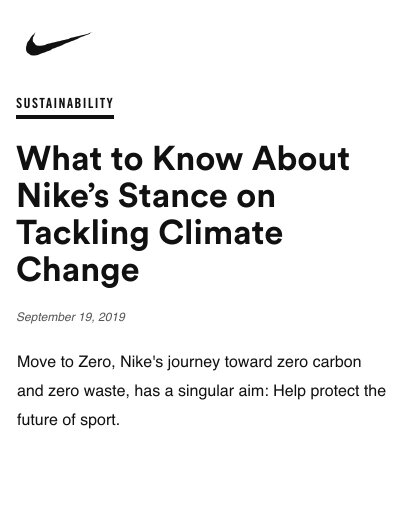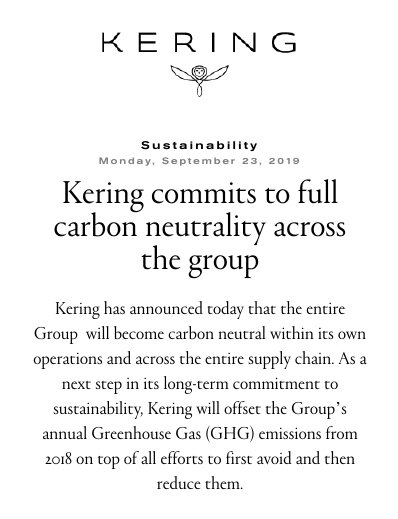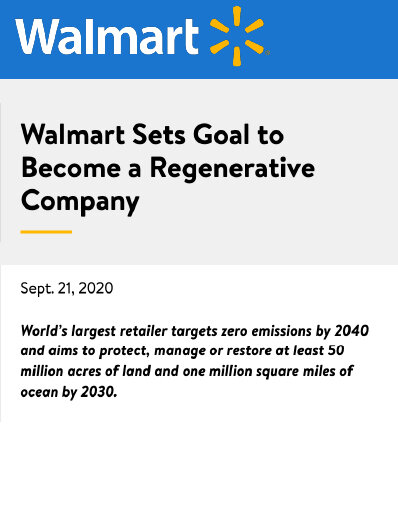Is net positive fashion even possible? And what should we do if it’s not?
28-03-2021
Living in a world of Climate Targets
Prior to the outbreak of Covid-19, it seemed that the latest trend in sustainability was climate target setting. Everyone was getting into it: cities, countries, companies, and, never one to not jump on a trend, the fashion sector.
Zero Emission, Zero Carbon, Carbon Neutral — Many different names for the same concept.
Many different terms are used to describe what is essentially the same thing: removing the same amount of greenhouse gases (CO2e) than is emitted.
How does a company go about achieving this state?
A company can: reduce emissions in their company and supply chain OR offset emissions by, for example, paying to have trees planted or not cut down, or paying to remove carbon dioxide from the atmosphere through geoengineering.
The big problem with the second option, offsetting emissions, is that the business behind it —carbon pricing— has proven to be enormously flawed. As Danny Cullenward, co-author of Making Climate Policy Work, said in an interview in David Robert’s Volts,
“The fundamental problem with offsets is that we can't observe what doesn't happen. The offset project is making a claim: if you didn't pay us, we wouldn't do this thing. It's a counterfactual claim that's factually unobservable. You can only infer, by evidence, reasoning, and detailed sector-specific knowledge, what might or might not happen. That's a challenging problem in the best of circumstances.”
And because it is priced, the game becomes where can the company find the cheapest offset and not the actual game of where can they most meaningfully reduce emissions. This game is seriously flawed because the cheapest offsets are also the lowest quality.
The bottom line is that we will not be able to offset our way to carbon neutral claims.
If offsets don’t work, where should fashion companies focus their efforts?
This leaves the work of actually reducing emissions within a company and its supply chain and in fashion the carbon hotspot is with suppliers (Scope 3 emissions, if you want the actual lingo) and most specifically at the mills, where enormous energy is required to turn a raw fiber into a yarn and then into a dyed and performance-finished fabric.
What needs to happen: In a world of business, it’s all about the Benjamins (and the Yuan, Taka and Dong).
So what’s happening at the mills? It’s not clear, and that is concerning.
In order to see actual measurable reductions, the mills that are responsible for reducing emissions - by making their operations more energy efficient and moving to renewable energy sources - need clear financial incentives to make these changes.
Suppliers are companies as well, if they invest in upgrades they have to see that they are going to get rewarded financially for their efforts (and money spent).
And this is where it’s not at all clear that the fashion companies are doing sufficient work. Language in the reporting is vague in this regard. We see talk of an “engagement campaign” (Fast Retailing) of working with suppliers on “a number of initiatives aimed to lower emissions” (Gap) and “Climate change performance is featured in supplier awards scheme” (Adidas), but that really does not tell us if there are meaningful incentives to make any changes. (Source: CDP.net)
So we should not be surprised that fashion companies are not showing meaningful progress on absolute carbon reductions.
If we are to be serious about addressing the climate crisis, we need backup.
Companies may be well intentioned, but we can’t forget they are businesses that operate to maximize profits. So we shouldn’t turn around and expect companies to get there by themselves. This is a clear area where the government needs to step in to set the rules of the game for all players - we just can’t afford for this to be a nice to have.
Calls for regulation in this regard are not just coming from us in the fashion space. The Chief Environmental Officer of Microsoft Lucas Joppa has said the same:
“If we are going to achieve a net-zero carbon economy for real, we will need everyone to act. And that means action can’t be voluntary. We need requirements and standards that everyone is expected to meet.”
As has the Tariq Fancy the former chief investment officer of Sustainable Investing at BlackRock, the largest asset manager in the world:
“We’re running out of time and need to accept the truth: To fix our system and curb a growing disaster, we need government to fix the rules.”
Conclusion: Fashion is a resource intensive process. To make that process exist within planetary bounds and where workers are not exploited along the way is going to take some rule setting.







